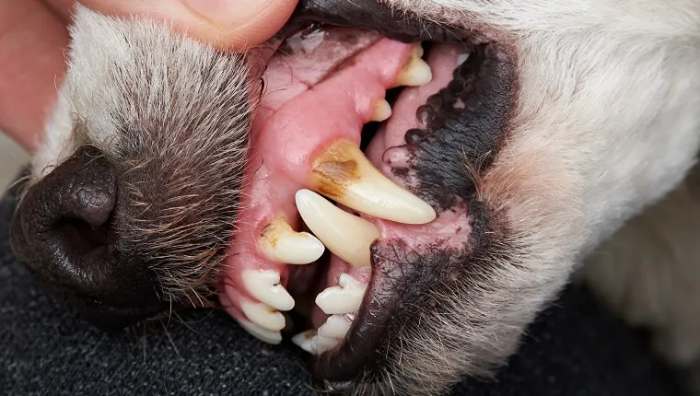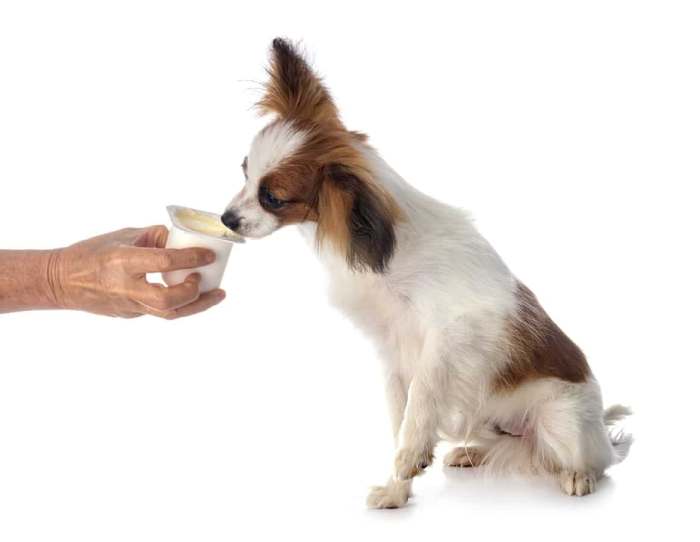As you navigate the fabled quest for fresher breath for your canine companion, consider Yogurt for Dog Bad Breath—your unexpected ally. You know the discomfort bad breath can cause, but did you know the solution might be as simple as your fridge’s dairy shelf?
This guide will unlock the secrets of choosing the right yogurt to combat your dog’s odorous exhalations while ensuring their safety and overall health. Let’s dive into the transformative powers of this humble food.
Understanding Dog Bad Breath: Identifying Causes and Concerns

Halitosis in dogs, which you might recognize as persistent bad breath, often signals underlying health issues that need attention. Dental diseases are among the primary culprits. Plaque buildup, gingivitis, or periodontitis can harbor bacteria, leading to foul odors. You’re dealing with a complex ecosystem in your dog’s mouth, where neglecting oral hygiene can result in significant dental pathology.
Additionally, dietary causes contribute to bad breath. Ingesting certain foods or a diet lacking nutrients can exacerbate the problem. You must evaluate your dog’s diet for quality and balance to ensure their digestive system isn’t contributing to their halitosis.
Identifying the root cause is crucial to effectively combat the issue and maintain your companion’s overall health.
The Power of Yogurt: How Probiotics Can Contribute to Oral Health
In your quest for remedies, you’ll find that incorporating plain yogurt into your dog’s diet can help freshen their breath by introducing beneficial bacteria to their oral microbiome. The probiotic benefits of yogurt are well-documented, including the promotion of a balanced gut flora that extends to the mouth:
- Probiotic Benefits:
- Enhances immune function
- Competes with pathogenic bacteria
Yogurt varieties differ, and it’s crucial to select the right type for your dog:
- Yogurt Varieties:
- Plain, unsweetened yogurt is optimal
- Avoid those with artificial sweeteners such as xylitol, which is toxic to dogs
Choosing a high-quality yogurt adds valuable probiotics to your dog’s diet, potentially improving their dental health and alleviating malodorous breath.
Choosing the Right Yogurt: Optimal Selection for Canine Consumption

When selecting yogurt for your dog’s bad breath, choose a high-quality, plain variety without added sugars or artificial flavors. Yogurt types vary significantly, but your aim should be to find one that provides the benefits of live cultures without unnecessary additives that could harm your pet.
It’s essential to consider your dog’s lactose sensitivity; some canines may experience digestive discomfort due to lactose present in many dairy products. To mitigate this risk, seek out yogurts that are specifically formulated to be low in lactose or lactose-free.
The live bacterial cultures in these yogurts can aid in maintaining oral health by balancing the oral microbiome, which can help freshen your dog’s breath. Always gradually introduce any dietary change, including yogurt, to monitor your pet’s response.
Serving Yogurt Safely: Guidelines for Introducing Yogurt into Your Dog’s Diet
To safely incorporate yogurt into your dog’s diet for fresher breath, you must determine the appropriate serving size based on their weight and dietary needs. Considerations for serving yogurt include:
- Appropriate Serving Size
- Small breeds: 1 teaspoon to 1 tablespoon
- Medium breeds: 1 to 2 tablespoons
- Large breeds: 2 to 3 tablespoons
- Yogurt Toppings and Additives
- Avoid: Sugary toppings and xylitol
- Choose Plain yogurt without artificial sweeteners or additives.
Be mindful of lactose intolerance; some dogs may display discomfort or gastrointestinal upset after consuming dairy. Start with small amounts to assess tolerance. Always opt for plain, unsweetened yogurt, and refrain from using yogurt toppings that could be harmful or exacerbate dental issues.
Additional Breath-Freshening Tips: Complementary Measures for Oral Hygiene
Beyond adding Yogurt for Dog Bad Breath, several other strategies can effectively combat bad breath. Dental chews are designed to reduce plaque and tartar accumulation, contributing to foul odors. These products promote oral health and fresher breath by mechanically scraping the teeth as your dog chews. Look for chews that carry the Veterinary Oral Health Council (VOHC) seal, which indicates efficacy in controlling plaque and tartar.
Additionally, water additives offer a convenient approach to maintaining oral hygiene. When added to your dog’s drinking water, these solutions can help neutralize bad breath. They often contain ingredients that target bacteria and reduce the sulfur compounds responsible for malodorous breath. Always choose products formulated for pets, ensuring their safety and suitability for canine consumption.
Frequently Asked Questions:
You must consider lactose alternatives if your dog shows intolerance symptoms, such as gastrointestinal upset, gas, or diarrhea. Careful symptom identification is key to addressing your pet’s dietary needs effectively.
Like every rose has its thorn, dog breeds may respond differently to the benefits of yogurt. Breed sensitivity to dairy can influence effectiveness in combating bad breath. Research your dog’s breed specifics.
Regularly feeding your dog yogurt with probiotics can improve dental hygiene by balancing oral bacteria, potentially reducing bad breath, and promoting healthier teeth and gums with consistent, moderate consumption.
It would be best if you didn’t give your dog flavored or sweetened yogurt due to harmful additives. Stick to plain yogurt with probiotic strains and add safe yogurt toppings like blueberries to entice them.
Specific yogurt types with natural probiotics may benefit oral health when considering long-term use. Still, you should monitor for any adverse effects of lactose intolerance or high caloric intake.
Conclusion:
You’ve unveiled the mystery of combating your pup’s pungent breath: yogurt could be the hero you’ve been seeking. Opt for plain, nonfat, and unsweetened varieties—these are pivotal.
Introduce it gradually, monitoring your furry friend. But remember, this isn’t a panacea; a holistic approach is key. Stay vigilant with dental hygiene practices.
The journey to fresher breath is nuanced; it blends the right choices and consistent care. The answer lies in balance and attention to detail.

Hey there, I’m Janet Brooks, a dog-loving student from California. I’m all about helping pups in need, especially those without homes. Me and my awesome friends work together to give shelter and love to stray dogs. Oh, and I also write blogs about dogs to share helpful info.